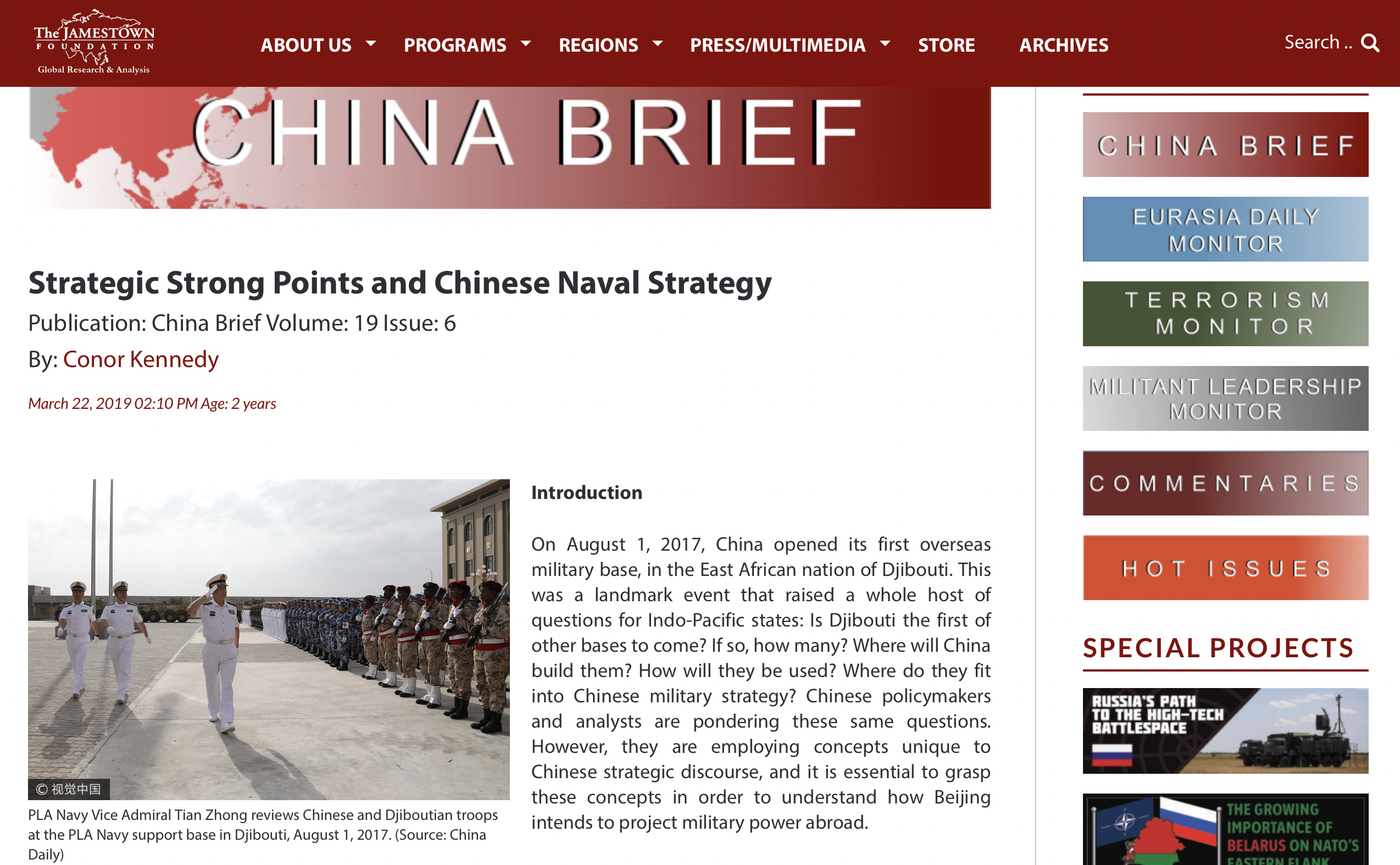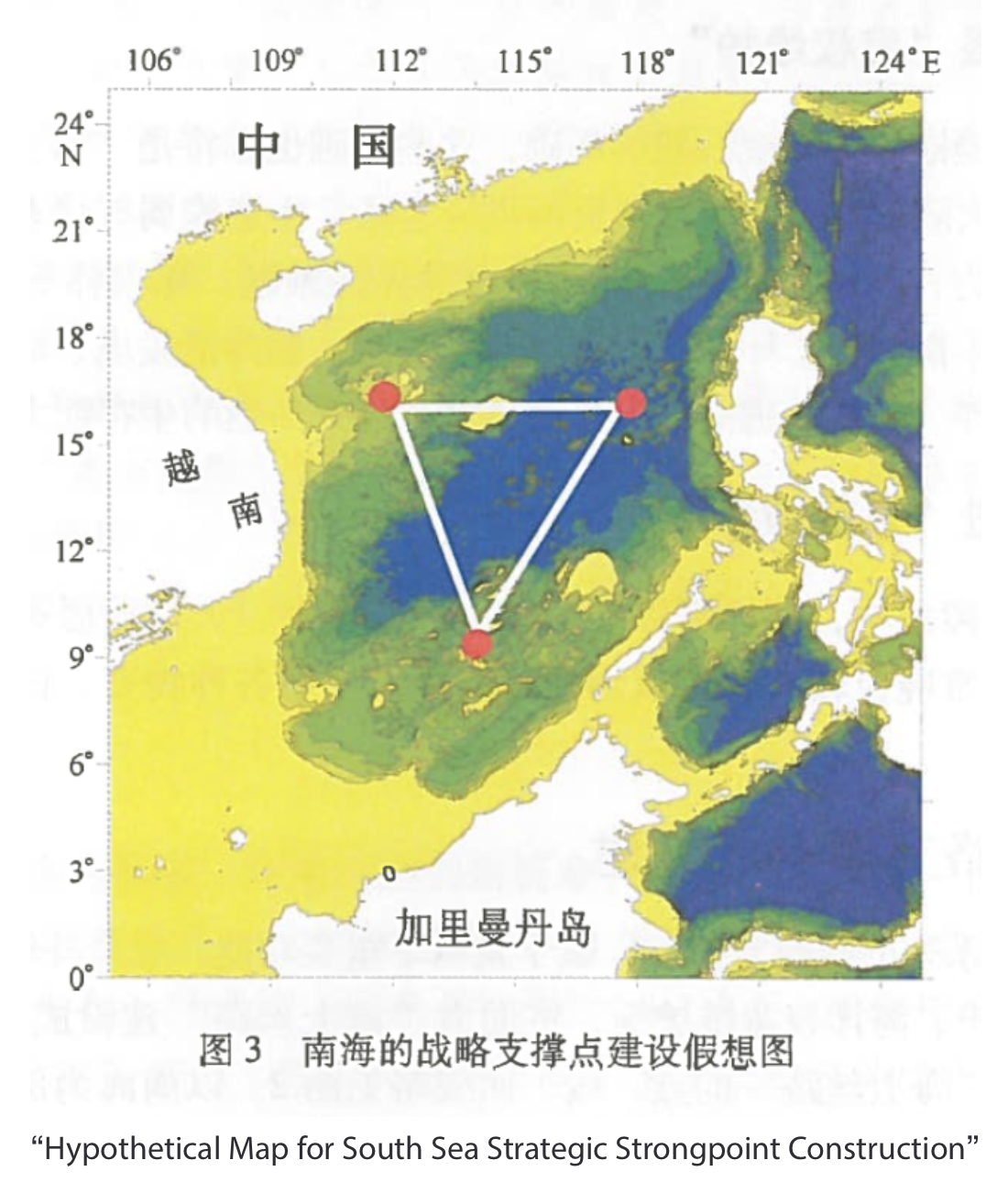Strategic Strong Points and Chinese Naval Strategy
Conor M. Kennedy, “Strategic Strong Points and Chinese Naval Strategy,” Jamestown China Brief 19.6 (22 March 2019).
Introduction
On August 1, 2017, China opened its first overseas military base, in the East African nation of Djibouti. This was a landmark event that raised a whole host of questions for Indo-Pacific states: Is Djibouti the first of other bases to come? If so, how many? Where will China build them? How will they be used? Where do they fit into Chinese military strategy? Chinese policymakers and analysts are pondering these same questions. However, they are employing concepts unique to Chinese strategic discourse, and it is essential to grasp these concepts in order to understand how Beijing intends to project military power abroad.
For the People’s Republic of China (PRC), the term “overseas military base” (haiwai junshi jidi, 海外军事基地) carries significant historical baggage: foreign imperialists built them on the soil of other countries in order to colonize and exploit them. On the other hand, Chinese policymakers have come to recognize the value of maintaining locations overseas where the Chinese military—above all, the People’s Liberation Army Navy (PLAN)—can concentrate resources needed to support operations abroad. To distinguish Chinese actions from the predatory deeds of Western and Japanese imperialists, Chinese military thinkers have adopted a specialized term: the “strategic strong point” (zhanlüe zhidian, 战略支点). [1] A careful analysis of the Chinese use of this concept offers valuable insights into Beijing’s strategic intentions outside of East Asia.
Understanding the “Strategic Strong Point” Concept
The term “strategic strong point” has different meanings, depending on the context in which it is used. In some cases it refers to a quasi-alliance relationship; in other cases, it is used in the context of overseas ports (Journal of Strategy and Decision-Making, No. 2, 2017). The 2013 Science of Military Strategy describes them as locations that “provide support for overseas military operations or act as a forward base for deploying military forces overseas” (Military Science Publishing, December 2013). The PLAN’s new facility in Djibouti has been called China’s first “overseas strategic strong point” (World Affairs, July 26, 2017).
The term is not just applied to Chinese bases: U.S. bases in the Pacific and Indian Oceans are also sometimes described as strategic strong points, and Chinese observers have spent considerable time examining these bases in order to inform their own thinking on developing overseas strategic strong points. Between 2016 and 2017, the PLAN’s official magazine Navy Today ran a series of articles, each one discussing the features and strategic roles of individual U.S. bases. One refers to Pearl Harbor as a “strategic strong point in America’s forward defense,” without which its defensive lines would be limited to the homeland (Navy Today, June 24 2016). Two others describe the roles of Diego Garcia and Guam as strategic strong points critical to Washington’s global strategy. [2]
However, Chinese experts are quick to point out that China’s strategic strong points are fundamentally different from those of other states. They state that China’s strategic strong points offer benefits to host states and provide them with public security goods. Moreover, these sites will not be used to conduct offensive operations, as is the case with the overseas bases of other states. [3]
The Need for Strategic Strong Points
Strategic strong points will improve the Chinese military’s ability to operate overseas. Currently, the PLAN conducts the vast majority of the PRC’s military missions abroad. The PLAN serves two primary functions: protecting China’s sea lines of communication (SLOCs), and safeguarding China’s overseas interests. Both require forward presence in strategically important areas of the Indo-Pacific. According to the Science of Military Strategy, an expansion of the geographic scope of naval operations requires the establishment of replenishment points and “various forms of limited force presence” (Science of Military Strategy, December 2013).
Strategic strong points fulfill these demands. An engineer at the Academy of Military Science’s Institute of Logistics explains that overseas strategic strong points will support the military’s long-range projection capabilities by effectively shortening resupply intervals and expanding the range of support for Chinese forces operating abroad (National Defense, December 2017). However, replenishment ships alone cannot meet the Navy’s needs. As the deputy chief of the PLAN Operations Department wrote in 2010, personnel relief, equipment servicing, and the uncertainties of foreign berthing facilities were limiting factors in the long-term regularization of overseas operations. Chinese facilities in overseas ports are the next step in building an “overseas support system.” [4]
PLAN Commander Adm. Wu Shengli talked about the importance of strategic strong points in December 2016, during an event commemorating the eighth anniversary of China’s anti-piracy operation off the Horn of Africa. Wu Shengli pointed out that “overseas strategic strong point construction has provided a new support for escort operations… We must give full play to the supporting role of the overseas support system to carry out larger scale missions in broader areas and to shape the situation.” [5]
Establishing several strategic strong points near crisis regions is integral to ensuring the sustained and effective use of forces in these roles. [6] When incidents and crises erupted in the past, efforts to protect China’s overseas interests were highly reactive. Strategic strong points allow China to gradually shift its posture to stabilize and control situations before they become crises. They might even play a role in stabilizing local governments and economies, and in ensuring civil order (International Herald Tribune, October 13 2015).
Accurate and timely intelligence is vital to effective operations, and PLA thinkers believe that strategic strong points will serve intelligence support functions. [7] Two authors from the PLA Equipment Academy write about the PLAN’s development of a “sea & space battlefield versatile situation picture” that integrates various intelligence sources to provide real-time visualized information support for the PLAN’s overseas actions. This system, they state, will support the PLAN’s defensive strategy in its strategic strong points, maritime passages, and core interest areas (Journal of Equipment Academy, April 2017). … … …








































